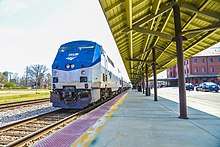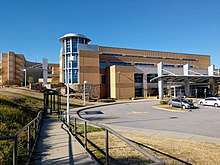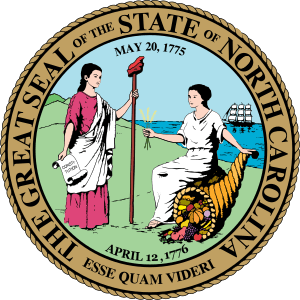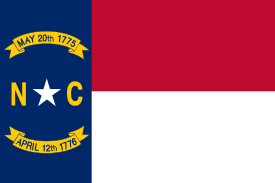Rocky Mount, North Carolina
Rocky Mount is a city in Edgecombe and Nash counties in the Atlantic coastal plain region of the U.S. state of North Carolina.[3][4] The city's population is estimated to be 53,922 as of 2019.[5] It is the principal city of the Rocky Mount metropolitan area, often called the "Twin Counties", which had an estimated population of 146,021 in 2018.[6][7] Rocky Mount is also an anchor city of the Rocky Mount-Wilson-Roanoke Rapids Combined Statistical Area in northeast North Carolina with a total population of 297,726 as of 2018.[8]
Rocky Mount, North Carolina | |
|---|---|
| City of Rocky Mount | |
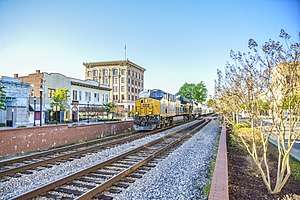 CSX train passing through Main Street in downtown. | |
 Logo | |
| Motto(s): The center of it all | |
 | |
| Coordinates: 35°56′18″N 77°47′26″W | |
| Country | |
| State | |
| Counties | Edgecombe, Nash |
| Founded | March 22, 1816 |
| Incorporated | February 19, 1867 |
| Government | |
| • Type | Council–Manager |
| • Mayor | Sandy Roberson |
| • City manager | Rochelle D. Small-Toney |
| • City council | Members
|
| Area | |
| • City | 44.40 sq mi (115.00 km2) |
| • Land | 44.20 sq mi (114.47 km2) |
| • Water | 0.21 sq mi (0.54 km2) |
| • Metro | 1,045.8 sq mi (2,708.5 km2) |
| Elevation | 98 ft (30 m) |
| Population (2010) | |
| • City | 57,477 |
| • Estimate (2019)[2] | 53,922 |
| • Density | 1,220.09/sq mi (471.08/km2) |
| • Urban | 68,243 (US: 406th) |
| • Metro | 146,021 (US: 288th) |
| • CSA | 297,726 (US: 111th) |
| Time zone | UTC−5 (EST) |
| • Summer (DST) | UTC−4 (EDT) |
| ZIP Codes | 27801, 27802, 27803, 27804, 27809, 27815 |
| Area code(s) | 252 |
| FIPS code | 37-57500 |
| GNIS feature ID | 1022368[3] |
| Interstate Highways | |
| U.S. Highways | |
| State Highways | |
| Website | www |
Incorporated in 1867, the community at the falls of the Tar River that became the city of Rocky Mount dates from the middle of the 1700s. Historically strong in rail transportation, textiles, and agriculture, the economy of Rocky Mount has diversified into biomedical pharmaceuticals, manufacturing, and logistics.[9][10] Forbes ranked the city as No. 6 for cost of doing business on its list of "Best Small Places For Business And Careers" in 2018.[11] Rocky Mount has also twice received the All-America City Award from the National Civic League in 1969 and 1999.[12]
History
Beginnings
The region around the Tar River was continuously inhabited by indigenous people for 12,000 years before the first Europeans arrived, when it was home to the Tuscarora people.[13] Europeans began settling the area after the Tuscarora War in the early 1700s.[14] Like many other early settlements in colonial America, they settled along the fall line between the Piedmont and coastal plain, which is the point at which rivers become unnavigable sailing upstream and water flowing downstream can power a mill.[13] The Falls of the Tar River Primitive Baptist Church was established in 1757, which still meets today, although its original building has since been replaced.[15] Much of the community attended the church so that it served as an early form of record keeping and law enforcement with citations given for crimes.[16]
19th century
%2C_Rocky_Mount%2C_Nash_County%2C_NC_HABS_NC%2C64-ROCMO%2C1-1.tif.jpg)
A post office was established at the falls of the Tar River on March 22, 1816. At this point, the name "Rocky Mount" officially appears in documented history, undoubtedly referring to the rocky mound at the falls of the Tar River. The second cotton mill in North Carolina followed soon thereafter, Rocky Mount Mills, in 1818.[4] Its proprietors were two entrepreneurs and Joel Battle, grandson of an original colonial settler to the area. Joel bought out the other proprietors before turning over the enterprise to his cousin James Smith Battle. The mill's spindles were initially operated by slaves until the 1850s and then worked exclusively by white women and girls. This female working arrangement lasted for the rest of the century.[6][17]
The Battle family was also involved in the construction of the longest continuous railroad in the world up to that time, the Wilmington and Weldon Railroad, which ran about two miles (3 km) east of the mill.[6] It connected the area to major ports in Virginia to the north and the port of Wilmington to the south. The tracks first reached Rocky Mount on Christmas Eve in 1839. In 1840, a train of cars en route to Wilmington stopped in Rocky Mount to import some "Old Nash" for special toasts at opening festivities and from there the fame of Nash County apple brandy spread. The railroad exerted a powerful influence on the development of the town so that, in 1871, the county line moved from the Tar River to its present location in the center of the tracks.[4] The Raleigh-Tarboro stage route also passed just below Rocky Mount (roughly where I-95 and U.S. 64 run today), and for a time was the logical debarking point for railroad travelers wishing to proceed east or west.[4]
The surrounding region was raided in 1863 during the Civil War by Union troops under the command of Brigadier General Edward E. Potter. The mill, which supplied Confederate yarn and cloth, was burned down. The mill was rebuilt after the war ended.[18] On February 19, 1867, the village outside the mill was incorporated as a town.[4]
The latter half of the 19th century saw the tobacco industry take shape in the state. Adjacent to the sandy coastal plain, Rocky Mount was well situated to take advantage of the rapidly rising demand for brightleaf tobacco that grew best in the sandy soil.[19] Tobacco also shaped the city's social life. Warehouses where tobacco was stored and marketed began hosting balls for the community in the 1880s that became known as "june germans" for the time of year and style of dance. June Germans eventually transformed into all-night dance parties and attracted musicians and socialites from miles around well into the 1900s.[20] By the end of the 19th century, tobacco had surpassed King Cotton as the town's primary agricultural product.[19]
20th century
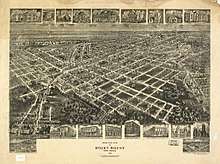
_article_of_August_26%2C_1938-p.1._From_Raleigh_News_%26_Observer_negative_(8514255914).jpg)
The turn of the 20th century saw Rocky Mount become the northern headquarters of the Atlantic Coast Line Railroad and its major repair shops and yard facilities located to the town. With it came an influx of railroad employees.[15] In 1900, Rocky Mount's population was around 3,000. On February 28, 1907, with a population around 7,500, Rocky Mount was officially incorporated as a city. A main railroad line, a well established cotton mill, and productive farmland for brightleaf tobacco were major contributors to the area's growth and prosperity over the next decades.[4] A vibrant central business district arose.[21] As in the rest of the South, though, racial segregation was imposed on the community leading to white suburbs largely on the west side of town, such as Villa Place and West Haven, and black neighborhoods largely on the east side of town, like Crosstown and Around the "Y" where Jazz legend Thelonious Monk was born.[22]
Several notable Civil Rights events occurred in Rocky Mount. In 1946, African American tobacco warehouse workers voted to organize in Rocky Mount as part of a broader nationwide movement known as Operation Dixie that lead to voter registration and political action against segregation.[23] On November 27, 1962, Martin Luther King Jr. gave a speech at Booker T. Washington High School wherein he used his famous refrain "I have a dream" a year before his better known delivery at the March on Washington.[24][25] The city also had its own sanitation workers' strike in 1978 when government sanitation workers protested their black co-worker being wrongfully arrested leading to his acquittal in court and the city later apologizing.[26]
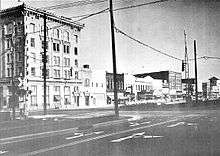
After WWII, the city continued to grow and the 1950s and 1960s saw the city's economy diversify into banking, manufacturing, pharmaceuticals, and the headquarters of a fast food chain known as Hardee's.[27] New educational facilities were also built including North Carolina Wesleyan College in 1956 and Nash Community College and Edgecombe Community College in 1968. In 1970, Rocky Mount received an All-America City Award. The 1970s also saw the consolidation of the city's hospitals under Nash General Hospital and the completion of Rocky Mount–Wilson Regional Airport.[28][4]
Like much of the rest of America, the 1980s onward saw urban decay of the inner city. Rocky Mount's downtown deteriorated but new neighborhoods and shopping malls were built like Golden East Crossing, and the city's boundaries expanded. In 1996, the town of Battleboro to the north of the city was annexed.[29][30] In 1999, the city won its second All-America City Award.[12]
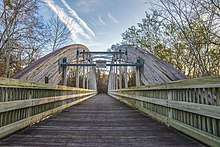
The fall of 1999 saw two hurricanes make landfall in eastern North Carolina. Both passed over Rocky Mount: Hurricane Dennis as a tropical storm in August with 20 inches (510 mm) of rain and Hurricane Floyd in September with nearly 17 inches (430 mm) of rain. Floyd is especially memorable because most localized flooding happened quickly overnight and many residents were not aware of the flooding until the water came into their homes, requiring many to be rescued. As a result of the hurricane, the already saturated Tar River suffered the worst flooding in its recorded history, exceeding 500-year flood levels along its lower stretches, and many homes and businesses were destroyed.[29][31][32]
21st century
The first decades of the 21st century have seen efforts to revitalize the historic downtown and projects to renovate buildings such as the train station and Douglas Block, or repurpose them like the Imperial Centre for Arts and Sciences and most recently Rocky Mount Mills.[33] In 2007, Capitol Broadcasting Company bought the mill and is in the process of turning it into a mixed-use campus of breweries, restaurants, lofts, and event space.[34] There have also been major new community projects such as the 143-acre (58 ha) sports complex and 165,000-square-foot (15,300 m2) downtown event center.[29] In 2019, CSX, the successor company of the Atlantic Coast Line Railroad, broke ground on a new intermodal cargo terminal that is expected to grow the local economy in the next decade.[35]
Geography
Rocky Mount is located in northeastern North Carolina, at the fall line between the Atlantic Coastal Plain to the east and the Piedmont region to the west. The city is 58 miles (93 km) east of Raleigh, the state capital, 91 miles (146 km) northeast of Fayetteville, 144 miles (232 km) north of Wilmington, 19 miles (31 km) north of Wilson, 42 miles (68 km) south of Roanoke Rapids, and 127 miles (204 km) south of Richmond, Virginia.
According to the United States Census Bureau, the city has a total area of 104.9 square miles (271.8 km2), of which 104.6 square miles (270.8 km2) is land and 0.4 square miles (1.0 km2), or 0.35%, is covered by water.[5] The Tar River passes through the city from west to east, crossing the fall line at Upper Falls and Little Falls and descending 25 feet (7.6 m) within the city limits. The city boundaries straddle the line between Edgecombe and Nash counties, which follows the railroad tracks through the center of the city running north to south.
Neighborhoods
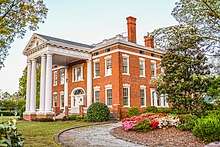
Historic Rocky Mount Mills Village
Situated near the Tar River, the Rocky Mount Mills Village grew in the late 19th and early 20th centuries as a small community of tenants working for the mill. Built between 1885 and 1940, each home is recognized by the National Register of Historic Places.[36] Changes in industrialization eventually forced the closing of the mill, and this way of life came to an end. However, when the mill closed, the property remained intact. Though the property has been a rental for its entire existence, covenants are placed on the property to assure home ownership and owner occupancy and protect the historical integrity.[37]
National Register of Historic Places
The Bellamy-Philips House, Bellemonte, Benvenue, Edgemont Historic District, Falls Road Historic District, Lincoln Park Historic District, Machaven, The Meadows, Rocky Mount Central City Historic District, Rocky Mount Electric Power Plant, Rocky Mount Mills, Rocky Mount Mills Village Historic District, Stonewall, Villa Place Historic District, and West Haven Historic District are listed on the National Register of Historic Places.[38]
Climate
Rocky Mount has a humid subtropical climate (Köppen Cfa) characterized by cool, sometimes moderately cold winters, and hot, humid summers.[39] The average high temperatures range from 51 °F (11 °C) in the winter to around 90 °F (32 °C) in the summer. The average low temperatures range from 31 °F (−1 °C) in the winter to around 69 °F (21 °C) in the summer.[40]
| Climate data for Rocky Mount, North Carolina | |||||||||||||
|---|---|---|---|---|---|---|---|---|---|---|---|---|---|
| Month | Jan | Feb | Mar | Apr | May | Jun | Jul | Aug | Sep | Oct | Nov | Dec | Year |
| Record high °F (°C) | 78 (26) |
82 (28) |
89 (32) |
96 (36) |
98 (37) |
106 (41) |
105 (41) |
103 (39) |
102 (39) |
101 (38) |
86 (30) |
80 (27) |
106 (41) |
| Average high °F (°C) | 48.9 (9.4) |
53.2 (11.8) |
61.2 (16.2) |
70.6 (21.4) |
78.4 (25.8) |
85.0 (29.4) |
88.6 (31.4) |
86.4 (30.2) |
79.9 (26.6) |
70.8 (21.6) |
61.7 (16.5) |
51.3 (10.7) |
69.6 (20.9) |
| Average low °F (°C) | 30.1 (−1.1) |
33.1 (0.6) |
39.6 (4.2) |
47.7 (8.7) |
56.1 (13.4) |
65.2 (18.4) |
68.9 (20.5) |
68.1 (20.1) |
60.7 (15.9) |
50.2 (10.1) |
40.4 (4.7) |
32.6 (0.3) |
49.4 (9.7) |
| Record low °F (°C) | −8 (−22) |
4 (−16) |
11 (−12) |
25 (−4) |
32 (0) |
43 (6) |
52 (11) |
45 (7) |
37 (3) |
19 (−7) |
16 (−9) |
0 (−18) |
−8 (−22) |
| Average precipitation inches (mm) | 4.13 (105) |
3.53 (90) |
4.35 (110) |
3.17 (81) |
3.82 (97) |
3.95 (100) |
4.88 (124) |
4.40 (112) |
5.32 (135) |
3.03 (77) |
2.83 (72) |
3.23 (82) |
46.64 (1,185) |
| Average snowfall inches (cm) | 1.2 (3.0) |
0.5 (1.3) |
0.3 (0.76) |
0 (0) |
0 (0) |
0 (0) |
0 (0) |
0 (0) |
0 (0) |
0 (0) |
0 (0) |
0.3 (0.76) |
2.3 (5.8) |
| Average precipitation days (≥ 0.0 in) | 9.8 | 8.6 | 9.6 | 8.2 | 9.3 | 8.9 | 10.4 | 9.5 | 7.6 | 6.9 | 7.3 | 9 | 105 |
| Source 1: NOAA[41] | |||||||||||||
| Source 2: Weather.com[40] | |||||||||||||
Demographics
| Historical population | |||
|---|---|---|---|
| Census | Pop. | %± | |
| 1870 | 357 | — | |
| 1880 | 552 | 54.6% | |
| 1890 | 816 | 47.8% | |
| 1900 | 2,937 | 259.9% | |
| 1910 | 8,051 | 174.1% | |
| 1920 | 12,742 | 58.3% | |
| 1930 | 21,412 | 68.0% | |
| 1940 | 25,568 | 19.4% | |
| 1950 | 27,697 | 8.3% | |
| 1960 | 32,147 | 16.1% | |
| 1970 | 34,284 | 6.6% | |
| 1980 | 41,283 | 20.4% | |
| 1990 | 48,997 | 18.7% | |
| 2000 | 55,893 | 14.1% | |
| 2010 | 57,477 | 2.8% | |
| Est. 2019 | 53,922 | [2] | −6.2% |
| U.S. Decennial Census[42] 2018 estimate[5] | |||
As of the census of 2010, 57,477 people, 23,097 households, and 14,639 families resided in the city. The population density was 1,312.6 inhabitants per square mile (606.7/km2). The city had 26,953 housing units. The racial makeup of the city was 61.3% African American, 32.4% White, 0.6% Native American, 1.0% Asian, and 1.6% from two or more races. Hispanics or Latinos of any race were 3.7% of the population.
Of the 23,097 households, 27.3% had children under the age of 18 living with them, 35.7% were married couples living together, 22.9% had a female householder with no husband present, and 36.6% were not families. About 31.4% of all households were made up of individuals living alone, and 26.6% had someone living alone who was 65 years of age or older. The average household size was 2.42 and the average family size was 3.04.
In the city, the population was distributed as 27.5% between the ages of 1 and 19, 6.4% from 20 to 24, 24% from 25 to 44, 27.9% from 45 to 64, and 14.2% who were 65 years of age or older. The median age is 38.7 years. 45.8% of the population are males compared to 54.2% for females.
The median income for a household in the city was $37,059, and for a family was $39,929. The per capita income for the city was $21,779. About 19.0% of the population is below the poverty line.[5]
Religion
Rocky Mount's population is 40.3% religiously affiliated, below the state average of 48.9%.[43] Christianity is the largest religion, with Baptists (13.3%) making up the largest religious group, followed by Pentecostals (4.5%) and Methodists (3.5%). Presbyterians (1.5%), Episcopalians (0.9%), and Catholics (0.8%) make up a significant amount of the Christian population as well. The remaining Christian population (15.2%) is affiliated with other churches. Islam (0.5%) is the second largest religion after Christianity.[44]
Economy
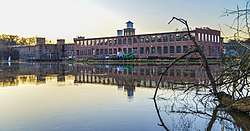
The economy of the Rocky Mount metropolitan area has been undergoing a process of transformation in the past few decades. While historically strong in textiles and agriculture, the economy has diversified into biomedical pharmaceuticals and manufacturing. Being at the juncture of a number of important highways and railway, distribution and logistics also play a key role in local business. In addition, the area has a strong service sector and is home to a number of financial and customer support centers.[9][10]
Rocky Mount's location less than an hour away from the state capital of Raleigh and the Research Triangle has helped attract new companies looking to balance a skilled labor force with significantly lower costs of living and doing business.[9] Forbes ranked the city as number six for cost of doing business on its list of Best Small Places For Business And Careers in 2018.[11]
The metropolitan area was named in a 2020 study as the third-highest in the United States where manufacturing is thriving with a manufacturing output of $6.2 billion, or $42,270 per capita. Between 2014 and 2018, manufacturing grew in the Rocky Mount area by 11.8%, and there were 108% more manufacturing jobs than the national average.[45][46]
Recent developments
In 2019, CSX Transportation broke ground on an approx. $200 million cargo terminal in Rocky Mount. While somewhat scaled back from original plans, the facility is still expected to have an indirect impact of over a thousand jobs in the area and has potential room for expansion.[47][35]
Chinese tiremaker Triangle Tire Co. will be building two manufacturing facilities at a 1,449-acre site in Edgecombe County, between Rocky Mount and Tarboro. Phase 1 of the project is set to open in 2020 and phase 2 in 2022. At $580 million, it will be the largest ever manufacturing investment in rural North Carolina with the creation of 800 jobs and an estimated contribution of more than $2.4 billion to the state's economy.[48] Across the road from the site, Corning has also announced a new $86 million warehouse that will bring 111 new jobs.[49]
The North Carolina Division of Motor Vehicles will be relocating its headquarters from Raleigh to Rocky Mount by October 2020. Over 300 employees will be moving into a building that was previously the headquarters of Centura Bank before it was acquired by RBC Bank (now PNC Bank) in 2001 and saw its workforce move to Raleigh.[50][51]
Largest employers
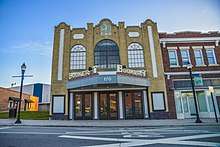

Below is a list of some of the largest employers in the metropolitan area as of 2018.[52]
| # | Employer | No. of employees |
|---|---|---|
| 1 | Pfizer | 3,000+[53] |
| 2 | Nash-Rocky Mount Public Schools | 2,275 |
| 3 | Cummins–Rocky Mount Engine Plant | 1,800 |
| 4 | Nash UNC Health Care | 1,600 |
| 5 | Edgecombe County Public Schools | 1,100 |
| 6 | QVC Distribution center | 1,100 |
| 7 | CenturyLink | 1,000 |
| 8 | Sara Lee Frozen Bakery | 950 |
| 9 | Alorica | 885 |
| 10 | City of Rocky Mount | 850 |
Shopping
Rocky Mount is the regional shopping destination for the metropolitan area with many big-box retailers and specialty shops located in the city. Rocky Mount's shopping centers are generally congregated along and around US 301 (Wesleyan Boulevard). Large centers include Golden East Crossing, Englewood Square, Sutters Creek Plaza, Cobb Corners, and Westridge Shopping Center. Golden East Crossing mall opened in 1986 and as of 2019 the mall features anchor stores Belk, Books-A-Million, Conn's, Dunham's Sports, J. C. Penney, and Ross Dress for Less.[54] Cobb Corners features anchors Walmart Supercenter, Burke's Outlet, Office Depot, Dollar Tree, and Lane Bryant, among 30+ other stores.[55] Sutters Creek Plaza features Big Lots, Tractor Supply Company, JOANN, and HomeTrends with a nearby Target and Hobby Lobby.[56]
In downtown, the recently renovated Douglas Block is a historically significant commercial block adjacent to the event center that composed the former African American business district.[57] Another commercial block to be found in downtown is Station Square next to city hall and the train station.[58]
Arts and Culture
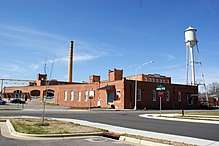
The city is home to multiple venues for the performing arts. The Imperial Centre for the Arts and Sciences hosts the Maria V. Howard Arts Center, a Children's Museum and Science Center, and a community theater.[59] The Dunn Center for the Performing Arts at Wesleyan College regularly has college arts performances and touring acts, and is also the home of the Tar River Orchestra and Chorus.[60][61] Most recently, the Rocky Mount Event Center opened in downtown with space to hold up to 5,000 seats for entertainment and sporting events.[62]
Rocky Mount Mills is a craft brewery incubator, the first of its kind on North Carolina, that is now home to many up-and-coming breweries and restaurants. In addition, the mill hosts summer music festivals and other events throughout the year. It has been in the process of redevelopment since 2014 by Capitol Broadcasting Company, which also owns the popular American Tobacco campus in downtown Durham, North Carolina. Nearby are dozens of historical homes for rent in the Rocky Mount Mills Village.[63][64] The next phase of development is Goat Island on the Tar River, which will offer public access to hiking trails, sandy beaches, and rafting/canoeing.[10]
A Rocky Mount Railroad Museum has been in the planning stages for a number of years given the cultural significance of the railroad on the city—in the early to mid-1900s the Emerson Shops alone of the Atlantic Coast Line Railroad employed over 2,000 people—but is currently without a facility.[27][65][66] It has been proposed to be located inside the train station.[67]
Sports and Recreation
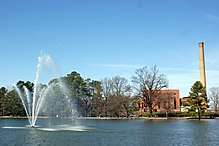
The Battling Bishops, North Carolina Wesleyan College's (NCWC) collegiate sports teams, compete in NCAA Division III as a member of the USA South Athletic Conference. Rocky Mount also has a history of minor-league baseball that ended with the Rocky Mount Pines of the Carolina League. The current regional minor-league team, the Carolina Mudcats, are located in the nearby town of Zebulon.
Rocky Mount is a major center for youth traveling sports as a midpoint between New York and Florida along I-95.[68] The Rocky Mount Sports Complex, maintained by the Parks and Recreation department, includes seven outdoor baseball fields, four softball fields, eight soccer fields, a professional disc golf course, basketball courts, and volleyball courts. The complex sees many statewide and interstate baseball and soccer tournaments. It also has a football stadium home to the NCWC Battling Bishops football team and Elizabeth City State University's annual Down East Viking Classic.[69] The recently opened Rocky Mount Event Center administered by the city has added eight indoor basketball courts, sixteen volleyball courts, a ropes course, a climbing wall, and a family entertainment center, with plans to host indoor basketball, volleyball, and gymnastics competitions.[68][70]
Tar River Trail is a 7-mile (11 km) greenway running east to west along the namesake river that connects with multiple parks, city landmarks, and the sports complex, with designated boat ramps for recreational paddling trips on the river. Notable among the connected parks is City Lake Park, built in 1937 during the Great Depression by the Works Progress Administration, and the 57-acre (23 ha) biodiverse Battle Park centered on the falls of the Tar River.[71][72] The trail also includes a 220-foot (67 m) long clear-span wooden bridge believed to be the longest such wooden bridge in the United States.[73]
Education
North Carolina Wesleyan College is a four-year private liberal arts college located in Rocky Mount and home to the Eastern North Carolina Center for Business and Entrepreneurship. The center's programs are free, open to the public, and focusing on business development, entrepreneurship, and community engagement.[74] The city is also served by Nash Community College, which has a brewing, distillation, and fermentation program in partnership with the Mills, and Edgecombe Community College, which has a downtown campus specializing in biotechnology and medical simulation.[75][76] Shaw University's College of Adult and Professional Education, or C.A.P.E., program also has a satellite campus in the Mills Village.[77]
The city of Rocky Mount is primarily served by the Nash-Rocky Mount Public School System, which as a whole has 15,000 students in 28 schools.[78] Parts of the city in Edgecombe County are also served by the Edgecombe County Public Schools system.[79] Public high schools include Nash Central High School, Northern Nash High School, Rocky Mount High School, Southwest Edgecombe High School and Southern Nash High School. The two nontraditional public schools are Tar River Academy and Nash Rocky Mount Early College. The one local charter school is Rocky Mount Preparatory School. There are also a number of private schools in the area.
Braswell Memorial Library serves the community as its major public library with affiliated libraries throughout the Twin Counties. It recently became part of the State Library's NC Cardinal consortium of public libraries that share an integrated system allowing books and other materials to be checked out from other libraries across the state.[80][81]
Government
The city of Rocky Mount has a council-manager form of government. The city is divided into seven wards with a total of seven council members elected to the city council, one from each ward. Members of the city council serve four-year terms with staggered elections every two years, while the mayor is elected at-large by citizens and serves a four-year term. The mayor is ex officio chair of the city council and only votes in case of a tie. The council appoints a city manager to serve as chief administrative officer of day-to-day affairs of government. As of 2017, the current city manager is Rochelle D. Small-Toney.[82]
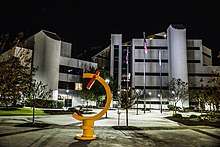
City council
- Sandy Roberson (Mayor)
- Andre Knight (Ward 1)
- Reuben C. Blackwell, IV (Ward 2)
- Richard Joyner (Ward 3)
- T. J. Walker (Ward 4)
- Lige Daughtridge (Ward 5)
- W. B. Bullock (Ward 6)
- Chris Carroll Miller (Ward 7)
Infrastructure
Roads and highways
The city is served by three major highways:



In the downtown area, both US 64 Bus. (Sunset Avenue / Thomas Street) and US 301 Bus. (Church Street) serve as major thoroughfares. State highways NC 43, NC 48 and NC 97 serve the city by connecting to nearby towns.
Airports
The Rocky Mount–Wilson Regional Airport (IATA: RWI, ICAO: KRWI, FAA LID: RWI) serves the general aviation needs of the surrounding counties. It is on NC 97, 9 miles (14 km) southwest of downtown Rocky Mount. The closest airport with scheduled commercial service is Pitt–Greenville Airport (PGV), 40 miles (64 km) to the southeast. Cargo and charter flights in the area also use the Kinston Regional Jetport (ISO), 50 miles (80 km) to the south. Raleigh-Durham International Airport (RDU), is 74 miles (119 km) to the west.
Rail
Amtrak provides three north and three southbound trains per day at the Rocky Mount station located in downtown. Service is to Washington, D.C., New York City, Miami and Philadelphia. Freight service is provided by CSX. Trains travel to destinations in eastern North Carolina and also to points west and south of the city.
Public transit
Tar River Transit provides public transportation in and around the city of Rocky Mount, and operates 10 fixed bus routes throughout the city.[83][84]
Health care
Nash UNC Health Care is a nonprofit hospital affiliated with UNC Health Care, which it joined in 2014. It has 345 beds at four different locations. Its flagship facility is Nash General Hospital.[85] When Nash General opened in 1971, it consolidated four different hospitals in the Rocky Mount area, and was the first all-private-room hospital in North Carolina.[86] Other hospitals operated are Nash Day Hospital, Bryant T. Aldridge Rehabilitation Center, and Coastal Plain Hospital. Nash UNC has added more facilities in recent years: a Surgery Pavilion in 2004, a renovated Emergency Department and Nash Heart Center in 2014, and Nash Women's Center in 2016. In 2018, the Danny Talbott Cancer Center facility opened, named in honor of a Rocky Mount athletic legend and cancer survivor.[85][87][88]
Media
Rocky Mount is considered part of the Raleigh-Durham-Fayetteville television and radio media market, the 25th largest in the United States. However, multiple broadcast stations in the Greenville-New Bern-Washington market also cover the city.
Locally, WHIG-TV, founded in 1997 and currently hosted out of Wesleyan College, and WNCR-LD, founded in 2002 and located in downtown, are Rocky Mount's community television stations.[89][90][91] WRQM 90.9 FM is the repeater station of public radio station WUNC, the local NPR affiliate. In the 1990s, it was known as "Down East Radio" and also hosted out of Wesleyan College.[92]
The Rocky Mount Telegram serves as the main daily newspaper for the city of Rocky Mount and surrounding areas.[93]
Notable people
- Andrew B. Anderson Jr. – U.S. Air Force lieutenant general and chief of staff born in Rocky Mount.[94]
- J. J. Arrington – NFL football player who attended Northern Nash High School in Rocky Mount.
- Thurbert Baker – the first African-American Attorney General in the State of Georgia born in Rocky Mount.
- F. C. Barnes – Gospel musician born in Rocky Mount.[95]
- Luther Barnes – Gospel music producer born in Rocky Mount.[95]
- Gardner Bishop – barber and civil rights activist born in Rocky Mount.
- Herman Boone – coach depicted by Denzel Washington in Remember the Titans born in Rocky Mount.[6]
- Benjamin Bunn – former U.S. congressman and first mayor of Rocky Mount who lived in historic Benvenue.[96]
- Jim Clack – NFL football player who won two Super Bowl championships with the Pittsburgh Steelers born in Rocky Mount.[6]
- Roy Cooper – Governor of North Carolina who attended Northern Nash High School in Rocky Mount.[97]
- Jeff Collins – member of the North Carolina General Assembly.[98]
- Elijah L. Daughtridge – 12th Lieutenant Governor of North Carolina born in Rocky Mount.
- Harold Denton – nuclear physicist born in Rocky Mount who advised the President during the Three Mile Island accident.[6]
- Mike Easley – former governor of North Carolina and state attorney general born in Rocky Mount.[97]
- Phil Ford – UNC and NBA basketball player born in Rocky Mount.[99]
- Jim Gardner – former U.S. congressman and lieutenant governor who cofounded Hardee's in the city.[6]
- Maureen Garrett – soap opera actress born in Rocky Mount.
- Alberta Gay – mother of Marvin Gaye born in Rocky Mount.[100]
- Kaye Gibbons – novelist who attended Rocky Mount Senior High School and wrote Ellen Foster.[6]
- Brian Goodwin – MLB baseball player for the Los Angeles Angels.
- Billy Godwin – former head baseball coach for East Carolina University born in Rocky Mount.[97]
- Allan Gurganus – author who wrote Oldest Living Confederate Widow Tells All born in Rocky Mount.[101]
- Bill Harrison – former CEO and chairman of JPMorgan Chase born in Rocky Mount.[97]
- Chuck Hinton – MLB baseball player born in Rocky Mount.[102]
- Matt Hill – Electric blues musician born in Rocky Mount.
- Earle Hyman – actor born in Rocky Mount who portrayed Cliff's father on The Cosby Show.[6][103]
- Terrence J – actor and co-anchor of E! News attended Northern Nash High School in Rocky Mount.[104]
- Jack Kerouac – father of the Beat Generation who resided with family off and on and referred to city as "Testament, Va." in On the Road.[105]
- Kay Kyser – big band musician, radio and film personality born in Rocky Mount.[106]
- Buck Leonard – Negro League baseball player; member of the National Baseball Hall of Fame.[107]
- Westray Battle Long – second director of Women's Army Corps under Dwight D. Eisenhower during World War II born in Rocky Mount.[108]
- Mae Mercer – Blues singer, actress and producer born in annexed former town of Battleboro.
- Thelonious Monk – Jazz pianist born in Rocky Mount.[109]
- William Murray – former football player and head coach at Duke University born in Rocky Mount.[110]
- Vann R. Newkirk II – journalist and staff writer for The Atlantic born in Rocky Mount.[111]
- Charles Pittman – NBA basketball player born in Rocky Mount.[112]
- Chuck Robbins – CEO of Cisco Systems who attended Rocky Mount High School.[113]
- Etaf Rum – New York Times best-selling author of A Woman is No Man who lives in Rocky Mount.[114]
- Susie Sharp – first female North Carolina Supreme Court justice born in Rocky Mount.
- The Swift – Christian pop band formed in Rocky Mount in the late 1990s.
- Danny Talbott – UNC and NFL quarterback who led Rocky Mount High School to state championships in football, basketball, and baseball.[87]
- Ken Thompson – former CEO and chairman of Wachovia born in Rocky Mount.[97]
- Jim Thorpe – Olympic gold medalist who played minor league baseball for the Rocky Mount Railroaders.[6]
- Mike Tyson – MLB baseball player born in Rocky Mount.[115]
- Phil Valentine – talk show radio host who attended Northern Nash High School in Rock Mount.[116]
- Tim Valentine – former U.S. congressman born in Rocky Mount.[6]
- Harold Vick – Jazz musician known for his work in the film School Daze (1988) born in Rocky Mount.
- Buck Williams – NBA basketball player born in Rocky Mount.[117]
- Mary Elizabeth Winstead – Emmy Award winning actress born in Rocky Mount.[118]
References
- "2019 U.S. Gazetteer Files". United States Census Bureau. Retrieved July 27, 2020.
- "Population and Housing Unit Estimates". United States Census Bureau. May 24, 2020. Retrieved May 27, 2020.
- "Rocky Mount". Geographic Names Information System. United States Geological Survey.
- "Information - City of Rocky Mount". City of Rocky Mount. Retrieved November 17, 2016.
- "Annual Estimates of the Resident Population: April 1, 2010 to July 1, 2018". American FactFinder. U.S. Census Bureau. Archived from the original on February 13, 2020. Retrieved July 15, 2019.
- Fleming, Monika (2013). Legendary Locals of Edgecombe and Nash Counties. Arcadia Publishing. ISBN 9781467100441.
- "Annual Estimates of the Resident Population: April 1, 2010 to July 1, 2018 - United States -- Metropolitan Statistical Area; and for Puerto Rico". American FactFinder. U.S. Census Bureau. Archived from the original on February 13, 2020. Retrieved July 15, 2019.
- "Annual Estimates of the Resident Population: April 1, 2010 to July 1, 2018 - United States -- Combined Statistical Area; and for Puerto Rico". American FactFinder. U.S. Census Bureau. Archived from the original on February 13, 2020. Retrieved July 15, 2019.
- Davis, Corey (March 2, 2018). "Area economy poised for growth". Rocky Mount Telegram. Retrieved May 18, 2018.
- Blake, Kathy (July 30, 2018). "The Nash-Edgecombe economy heats up". Business North Carolina. Retrieved April 9, 2019.
- "Rocky Mount, NC". Forbes. Retrieved July 22, 2019.
- "Previous Winners". National Civic League. Retrieved 21 November 2016.
- Coscolluela, Nicole. "Landscape and Environment". Digital Rocky Mount Mills. UNC-Chapel Hill Community Histories Workshop. Retrieved March 27, 2019.
- Coscolluela, Nicole. "Native American Connections". Digital Rocky Mount Mills. UNC-Chapel Hill Community Histories Workshop. Retrieved March 27, 2019.
- Fleming, Monika (1998). Rocky Mount and Nash County. Arcadia Publishing. ISBN 9780752412139.
- Dune, Sierra. "Lying About the Age of a Horse: The Primitive Baptist Church on The Falls of the Tar River Records". Digital Rocky Mount Mills. UNC-Chapel Hill Community Histories Workshop. Retrieved March 27, 2019.
- Gaddis, Elijah. "Early Mill History". Digital Rocky Mount Mills. UNC-Chapel Hill Community Histories Workshop. Retrieved March 27, 2019.
- Kelley, Lucas. "The Civil War". Digital Rocky Mount Mills. UNC-Chapel Hill Community Histories Workshop. Retrieved March 27, 2019.
- Biles, Roger (April 2007). "Tobacco Towns: Urban Growth and Economic Development in Eastern North Carolina". The North Carolina Historical Review. 84 (2) (2nd ed.). North Carolina Office of Archives and History: 156–190. JSTOR 23522906. Cite journal requires
|journal=(help) - Tomlin, Jimmy (2014). "Dance Till Dawn". Our State.
- Eckard, J. Eric (February 28, 2012). "1910 - 1934: Headlines have a familiar ring". Rocky Mount Telegram. Archived from the original on February 15, 2016.
- Kelley, Robin (2009). Thelonious Monk: The Life and Times of an American Original. Simon and Schuster. ISBN 9781439190494.
- Korstad, Robert (2003). Civil Rights Unionism: Tobacco Workers and the Struggle for Democracy in the Mid-twentieth-century South. University of North Carolina Press. ISBN 9780807854549.
- Shaffer, Josh (August 11, 2015). "Martin Luther King's Rocky Mount dream speech rings out again". News & Observer.
- "Home - King's First Dream". King's First Dream. Retrieved March 27, 2019.
- Kay, Lindell John (October 9, 2018). "Council apologizes for historic strike". Rocky Mount Telegram.
- Henderson, John (February 28, 2012). "1935 - 1959: Bustling times in post-War era". Rocky Mount Telegram. Archived from the original on July 9, 2015. Retrieved April 10, 2019.
- Cooper, Geoffrey (February 28, 2012). "1960 - 1984: Tobacco, textiles fuel economy". Rocky Mount Telegram. Archived from the original on September 1, 2014.
- Handgraaf, Brie (February 28, 2012). "1985 - 2010: New dynamics drive change". Rocky Mount Telegram. Archived from the original on September 1, 2014.
- North Carolina General Assembly, Battleboro/Rocky Mount merger, House Bill 1177, 1995 Session, Retrieved Aug. 16, 2017.
- Friends of Braswell Library (2004). Flooded: Reflections of Hurricane Floyd. Chapel Hill Press. ISBN 9781880849989.
- Bales, Jerad D. "USGS: 1999 North Carolina Flooding: Summary". Pubs.usgs.gov. Retrieved 2010-12-09.
- "Professional's Category: Great Main Street In-the-Making - Rocky Mount". American Planning Association-North Carolina Chapter. Retrieved April 15, 2019.
- Abrams, Amanda (June 18, 2018). "Revitalizing a Historic Mill Town in North Carolina". Urban Land. Retrieved April 15, 2019.
- West, William F. (March 16, 2019). "CSX to break ground for rail hub in April". Rocky Mount Telegram.
- "History - Rocky Mount Mills". Rocky Mount Mills. Retrieved April 9, 2019.
- Michelle Kullen (December 1998). "Rocky Mount Mills Village Historic District" (PDF). National Register of Historic Places - Nomination and Inventory. North Carolina State Historic Preservation Office. Retrieved November 15, 2016.
- "National Register Information System". National Register of Historic Places. National Park Service. July 9, 2010.
- "Rocky Mount, North Carolina Köppen Climate Classification". Weatherbase. Retrieved November 12, 2019.
- "Rocky Mount, NC Monthly Weather Forecast - weather.com". The Weather Channel. Retrieved November 12, 2019.
- "Station Name: NC ROCKY MT WILSON AP". National Oceanic and Atmospheric Administration. Retrieved November 12, 2019.
- "Census of Population and Housing". United States Census Bureau. Retrieved January 25, 2013.
- "North Carolina Religion". Bestplaces.net. Retrieved November 12, 2019.
- "Rocky Mount, North Carolina Religion". Bestplaces.net. Retrieved November 12, 2019.
- Qin, Johan (January 23, 2020). "Top Cities Where U.S. Manufacturing is Thriving". AdvisorSmith. Retrieved May 14, 2020.
- Carney, Spencer (February 9, 2020). "City receives high ranking for manufacturing". Rocky Mount Telegram. Retrieved May 14, 2020.
- Davis, Corey (March 2, 2018). "CSX plans for property still unclear". Rocky Mount Telegram. Retrieved May 18, 2018.
- Davis, Corey (December 20, 2017). "Tire plants to create 800 jobs". Rocky Mount Telegram. Retrieved May 18, 2018.
- Davis, Corey (July 15, 2018). "Corning prepares to construct new warehouse". Rocky Mount Telegram. Retrieved May 18, 2018.
- West, William F. (March 5, 2019). "DMV relocation approved". Rocky Mount Telegram. Retrieved March 10, 2019.
- Holder, Sarah (March 20, 2019). "North Carolina's Contentious Bid to Bridge the Urban-Rural Divide". Citylab. Retrieved April 10, 2019.
- "Major Employers in Rocky Mount MSA (Edgecombe & Nash) 2018" (PDF). econdev.org. Retrieved April 19, 2019.
- Davis, Corey (October 14, 2018). "Pfizer plant adds 800 workers". Rocky Mount Telegram. Retrieved June 30, 2019.
- "Golden East Crossing Mall - Rocky Mount, NC". Golden East Crossing. Hendon Properties. Retrieved July 28, 2019.
- "Cobb Corners". Tricor Property. Retrieved 28 July 2019.
- "Sutters Creek Plaza". CREXi. Retrieved August 5, 2019.
- "Downtown Redevelopment-Rocky Mount's Douglas Block". Community and Economic Development. Retrieved November 16, 2016.
- Davis, Corey (September 8, 2017). "Additions planned at Station Square". Rocky Mount Telegram. Retrieved April 10, 2019.
- "About Us - Imperial Centre for the Arts & Sciences". Imperial Centre for the Arts & Sciences. Retrieved April 9, 2019.
- "General Information - North Carolina Wesleyan College". North Carolina Wesleyan College. Retrieved April 9, 2019.
- "About - Tar River Orchestra & Chorus". Tar River Orchestra & Choir. Retrieved April 16, 2019.
- John Kay, Lindell (October 26, 2018). "Free concert launches event center". Rocky Mount Telegram. Retrieved October 27, 2018.
- "CBC Purchases Vacant Rocky Mount Mill". Capitol Broadcasting Company. July 16, 2007. Retrieved November 16, 2016.
- Baverman, Laura (July 30, 2014). "The Rocky Mount Brewmill: Crafting North Carolina's future in beer". WRAL. Retrieved 16 November 2016.
- Sayblack, Philip (January 17, 2016). "Committee has train museum plan on track". Retrieved April 10, 2019.
- "History - Rocky Mount Railroad Museum". Rocky Mount Railroad Museum. Retrieved March 9, 2019.
- Kay, Lindell John (May 27, 2019). "Council to weigh property leases". Rocky Mount Telegram. Retrieved June 2, 2019.
- Henderson, John (August 17, 2015). "Tourism plays vital role in local economy". Rocky Mount Telegram. Retrieved April 16, 2019.
- Henderson, John (November 16, 2011). "Sports complex draws youth, tourism dollars". Rocky Mount Telegram. Retrieved April 16, 2019.
- Kay, Lindell John (April 16, 2019). "Event Center to host state gymnastics championships". Rocky Mount Telegram. Retrieved April 16, 2019.
- Sayblack, Philip (August 10, 2016). "City considers upgrades to Battle Park". Rocky Mount Telegram. Archived from the original on August 14, 2016.
- "Friends of Battle Park - Preserving a Natural Gem in our city". Friends of Battle Park. Retrieved April 15, 2019.
- Banowetz, Jeff (April 2002). "Bridging the Gap". Recreation Management. Retrieved April 15, 2019.
- Davis, Corey (December 14, 2018). "New director leads business center". Rocky Mount Telegram. Retrieved April 16, 2019.
- Deal, Kelley (August 26, 2018). "NCC brewing program taps new instructors". Rocky Mount Telegram. Retrieved April 16, 2019.
- "Biotechnology and Medical Simulation Center at ECC One of Two in the State - Golden LEAF Foundation". Golden LEAF Foundation. Retrieved April 15, 2019.
- Harper, Amelia (August 17, 2016). "Shaw site moves to mill village". Rocky Mount Telegram. Retrieved July 15, 2019.
- "2017 Fast Facts" (PDF). Nash-Rocky Mount Public Schools. Retrieved April 15, 2019.
- "Schools - Edgecombe County Public Schools". Edgecombe County Public Schools. Retrieved April 15, 2019.
- "Home - Braswell Memorial Library". Braswell Memorial Library. Retrieved April 10, 2019.
- Roche, Catherine (February 24, 2019). "Braswell joins library consortium". Rocky Mount Telegram. Retrieved April 15, 2019.
- "Mayor & City Council - City of Rocky Mount". City of Rocky Mount. Retrieved November 21, 2016.
- "Welcome Aboard Rocky Mount's Tar River Transit". Tar River Transit. Retrieved November 17, 2016.
- "Routes and Schedules". Tar River Transit. Retrieved 17 November 2016.
- "About Us - Nash UNC Health Care". Nash UNC Health Care. Retrieved April 19, 2019.
- "Our History - Nash UNC Health Care". Nash UNC Health Care. Retrieved April 19, 2019.
- Davis, Corey (February 4, 2018). "Talbott honored, humbled by cancer center naming". Rocky Mount Telegram. Retrieved April 21, 2019.
- Davis, Corey (May 6, 2016). "New women's center opens at Nash UNC Health Care". Rocky Mount Telegram. Retrieved November 21, 2016.
- "FCC Public Inspection File". Federal Communications Commission. Retrieved April 9, 2019.
- "WHIG-TV sets up shop on Wesleyan campus". Rocky Mount Telegram. December 13, 2017. Retrieved June 2, 2019.
- West, William (May 30, 2019). "Local TV station moves to downtown location". Rocky Mount Telegram. Retrieved June 2, 2019.
- "Raleigh-Durham FM Dial". Archived from the original on February 1, 2003. Retrieved July 1, 2017.
- "Home - Rocky Mount Telegram". Rocky Mount Telegram. Retrieved May 15, 2018.
- "Lt. Gen. Andrew B. Anderson Jr". United States Air Force. April 1, 1979.
- "Pioneer, Bishop Faircloth "F.C." Barnes Goes on to Glory". Gospel Today. July 17, 2011.
- Smith, Jr., Claiborne T. "Bunn, Benjamin Hickman - NCpedia". NCpedia. Retrieved July 15, 2019.
- "Notables - Explore Nash County". Explore Nash County. Retrieved April 9, 2019.
- Ovaska-Few, Sarah (February 4, 2011). "The New Crop – Rep. Jeff Collins". NC Policy Watch.
- "Phil Ford basketball-reference.com profile". Basketball-Reference.com. Retrieved 10 September 2014.
- Ritz, David (1991). Divided Soul: The Life of Marvin Gaye. Cambridge, Mass: Da Capo Press. pp. 5–6. ISBN 978-0-306-81191-3.
- "Eight Famous People From Rocky Mount, North Carolina - Rocky Mount Review". Retrieved 16 May 2016.
- Schudel, Chuck (30 January 2013). "Chuck Hinton, last Washington Senator to hit .300, dies at 78". The Washington Post. Retrieved 1 February 2013.
- "Earle Hyman - Biography - IMDb". Retrieved 16 May 2016.
- "Foot Locker Partners with E! News Co-Anchor Terrence Jenkins for Back-to-School - WSJ.com". Retrieved 10 September 2014.
- Dorfner, John J. (September 23, 2007). "The Road to Rocky Mount". News & Observer. Raleigh. Retrieved March 27, 2019.
- "Kay Kyser". North Carolina Music Hall of Fame. Retrieved 18 November 2016.
- "Leonard Buck | Baseball Hall of fame". Hall of Famers. National Baseball Hall of Fame and Museum. Retrieved 17 July 2011.
- Nicholas, Westray B. (1991). "Long, Westray Battle". NCpedia.
- Solis, Gabriel (2007). Monk's Music: Thelonious Monk and Jazz History in the Making. University of California Press. pp. 19–20. ISBN 9780520940963.
- "William Murray - Twin Counties Hall of Fame". Twin Counties Hall of Fame. Retrieved April 11, 2019.
- Newkirk II, Vann R. (August 22, 2017). "Growing Up in the Shadow of the Confederacy". The Atlantic. Retrieved June 6, 2019.
- "Charles Pittman Stats - Basketball-Reference.com". Basketball-Reference.com. Retrieved April 11, 2019.
- "Meet Rocky Mount High, UNC graduate Chuck Robbins, next CEO of Cisco". WRAL Techwire. May 4, 2015. Retrieved April 11, 2019.
- White, Jenny (June 18, 2019). "Local author pens best-selling novel". Rocky Mount Telegram. Retrieved June 30, 2019.
- "Mike Tyson Stats - Baseball-reference.com profile". Baseball-Reference.com. Retrieved April 11, 2019.
- "Family, friends pay respect to Valentine". Rocky Mount Telegram. November 15, 2015. Retrieved April 11, 2019.
- "Buck Williams basketball-reference.com profile". Basketball-Reference.com. Retrieved 10 September 2014.
- "Mary Elizabeth Winstead - Maxim". Maxim. Archived from the original on 4 November 2012. Retrieved 10 September 2014.


